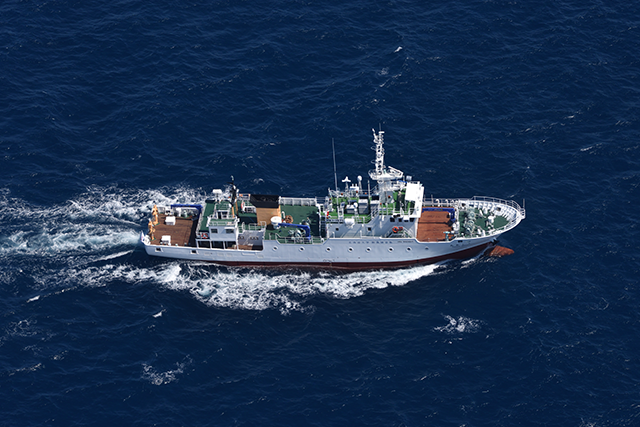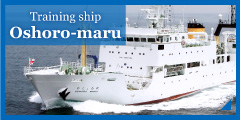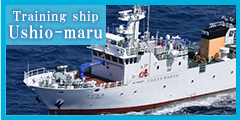History of construction
The first Ushio Maru I was built in 1971 and used mainly in the waters around southern Hokkaido, Tsugaru Strait, and Mutsu Bay for experiments, practical training, surveys, and research on ocean physics, chemistry, biology, fisheries, fishing boats, fishing gear, physiology, ecology, and fish biology.
The Ushio Maru II was built in 1992, and in 2002, its hull was extended, its onboard facilities were expanded, and its research and observation equipment was upgraded, resulting in numerous achievements for the training vessel. However, after 30 years of operation, the aging hull, engine, navigation instruments, and research equipment made navigation and research difficult, so a replacement vessel was built.
In 2001, the Faculty of Fisheries at Hokkaido University accelerated its emphasis on graduate education by abolishing a special training course for obtaining a maritime license and shifting its education and research focus from “fisheries” to “fisheries science” to enhance the sustainability of the aquatic environment, further promoting interdisciplinary research. The newest vessel, the Ushio Maru III, offers a practical platform for comprehensive education and research in fisheries science that aims to improve the sustainability of marine ecosystems and in related fields in the ocean, which is a common asset of mankind. Its hull shape and structure were designed to ensure safety, reduce hull rolling, and require no large-scale repairs for at least 30 years; its living space was designed to be more comfortable for both male and female passengers and crew; and its fuel efficiency has been improved. Equipped with the latest survey equipment to conduct advanced ocean surveys, it will continue to serve as an education and research base for exchange and joint research with universities and research institutes, and charter research projects.
Purpose of the training ship Ushio Maru
The Ushio Maru is a training vessel for students at the School of Fisheries Sciences, Graduate School of Fisheries Sciences, and Graduate School of Environmental Science to receive fisheries training and to conduct oceanographic observations and other research in both Japanese and international waters:
- Fishery Training
・Trawl fishing
・Longline fishing
・Surface and midwater gillnet fishing
・Squid jigging - Ocean Observations and Research
・Oceanographic observations using a CTD
・Surveys of catch performance using various fishing gear
・Quantitative surveys of fishery resources
・Biological resource surveys and seafloor surveys using acoustic instruments
・Coastal remote sensing using drones
・Micronekton collection
・Microplastic and seafloor debris surveys, sediment sampling, etc.
Appropriate measures have been taken to reduce noise, vibration, and bubbles generated from the hull such as placing acoustic equipment transmitters and receivers in sonar domes on the bottom of the ship to not interfere with the observation functions of the acoustic equipment. The ship’s hull form was designed and developed specifically to reduce the underwater noise level generated at a ship speed of 10 knots to below the ICES recommended standard. This was done by increasing the hull plate thickness and taking anti-vibration measures for equipment in the engine room and other compartments to reduce their effects on acoustic equipment and to improve the accuracy of the collected data.
1. Range of experiments and training
Physical Oceanography, Chemistry Oceanography, Biological Oceanography, Marine Ecology, Marine Biosource production, Fisheries Resource Measurement, Fisheries Behavioral Research, Marine Chemical Resource Development
2. Fishing methods
Stem trawling, Longline fishing, Cage fishing, Gill-net fishing, Single hook fishing, Squid jigging, etc.
3. Main areas of research
- Physical, chemical, biological, and ecological studies of the marine environment
- Fluctuations in sea and fishery conditions, Changes in biosources, Resource management
- Physics and ecology of fishing gear, fishing methods, fishing-gear design
- Ecology of fishes, cephalopods, marine mammals, plankton, and benthos
- Efficiency and safety engineering of fishing machinery
- Resource measurement, Hydroacoustic remote sensing
- Exploring the useful materials from marine organisms
PARTICULARS
PRINCIPAL PARTICULARS
| Length(overall) | 45.62m |
| Registered length | 39.06m |
| Length(between pp.) | 38.70m |
| Breadth(molded) | 8.20m |
| Depth(molded) | 3.40m |
| Designed full load draft(molded) | 2.85m |
| Gross tonnage | 262ton |
| International tonnage | 409ton |
| Speed(Trial maximum) | 14.48 kt |
| Speed(Service) | abt.11.00 kt |
| Main engine | YANMAR 6EY22AW |
| Rated output | 1330 kW/900 min-1 |
|
Complement(total) Crews Professors & Students |
33persons 16persons 17persons |
| Keel laid | 22 December 2021 |
| Launched | 19 March 2022 |
| Completed | 31 October 2022 |
Builder
NIIGATA SHIPBUILDING & REPAIR,INC.



